Focusing the new way
06:25 5/8/2009 UTC
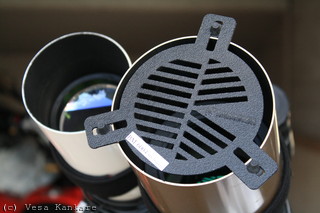
Focusing is a very important task while preparing to take a good astrophoto. I say it is the hardest part if you want repeatedly a good focus, at least with my equipment. Nebulosity2 has very good routine for fine focusing and I've gotten very good results with it, but it takes time to confirm the best focus. Seeing, filters and star brightness also varies the absolute measures of focus from night to night. Enter Bahtinov mask. This clever focusing aid generates three bright diffraction spikes around a star. When these spikes cross each other symmetrically, the telescope is focused. And this is not affected by seeing in any way, so repeating good focus from night to night should be easier and faster. Of course it's cloudy here, so I'll have to wait to test it in practise. I bought mine from Kendrick Astro Instruments, but this should be relatively easy to do it yourself also.
Preparations for fall
05:18 26/7/2009 UTC
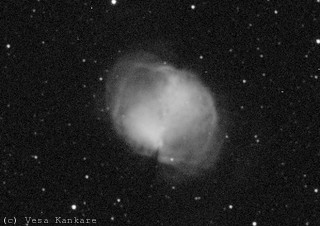
Brightest constellations are already visible after midnight, so it is time to begin preparations for the next season. My goal was to get the system dither between exposures and to try out Nebulosity2 with CCD. After some struggle with guiding, I got everything to work. I just received two of the three new narrowband filters, so I had to try a traditional fall object M27 with it. I did three 600s OIII exposures. Altough the sky is still bright, very dim outer parts of the nebula is starting to come out. This is 100% crop from the center of the frame.
M51 - The Whirpool Galaxy
20:11 15/4/2009 UTC
What a spectacular conditions. SQM read almost 22 and sky was pristine and seeing was very good. And I just happened to be testing at Ursa observatory again with 91cm telescope. Despite of few challenges I managed to get some 20 good 45s exposures from M51. This time I also added some colour data from my earlier image taken with 8 inch newton and DSLR. This is a bit quick processing, I might update the image after a while. Very nice observing site and very exciting telescope!
NGC/IC Object List:
NGC5194 galaxy RA:13h29m52.6 Dec:+47°11m'44" BMag: 8.9, M 51 Whirlpool Galaxy
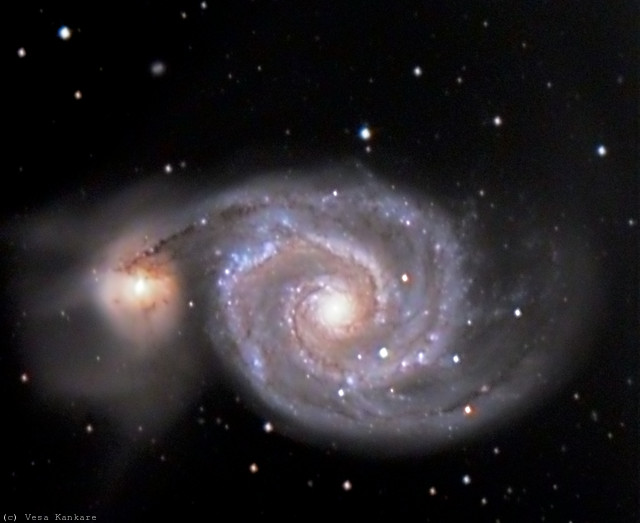
Camera: Atik Instruments 4000LE, Modified Canon EOS 350D | Telescope: Ursa Artjärvi Observatory 91cm f3.75 Astrofox Folded Newton, Orion Optics Europa 200mm f6 Newtonian reflector | Mount: Ursa Dome 1 | Filters: Baader IR/UV block | Guiding: - | Exposure: L 20x45s binned 2x2 CCD @ -20° f3.75 | Software: CCDWare CCDStack, Adobe Photoshop CS4, GradientXTerminator Plugin, Artemis Capture | Location: 60°44'00"N 26°12'46"E (Tähtikallio Observatory/Artjärvi, FI) | Background sky brightness (SQM): 21.50 mag/arcsec² | Target altitude in the beginning of the exposure 68°
Spring Galaxies
20:08 31/3/2009 UTC
I was privileged to have my camera attached for the first astroimaging test with a monster telescope of Ursa Amateur Astronomy Association 91cm folded newton telescope in Artjärvi Observatory. Lots of work with that telescope is still needed but some results were possible. It is amazing how well this first test went, knowing the FL is almost about 3.5m, focal ratio is 3.75 and the beast weights like one metric tonne! This scope has a great potential to reveal some interesting structure from planetary nebula and dim galaxies when everything is tuned to max and one can really have looong exposures.
I made a collage from the images we took that night. It took under a two hours to gather all this. Image exposures varies from 9 to 21 frames, all 20s each. That was enough to reach a sky limit in 21 mag/arcsec2 sky.
NGC/IC Object List:
NGC5194 galaxy RA:13h29m52.6 Dec:+47°11m'44" BMag: 8.9, M 51 Whirlpool Galaxy
NGC5195 galaxy RA:13h29m59.2 Dec:+47°16m'03" BMag:10.5, UGC 8494
NGC5055 galaxy RA:13h15m49.0 Dec:+42°01m'59" BMag: 9.3, M 63 Sunflower Galaxy
NGC4826 galaxy RA:12h56m43.8 Dec:+21°40m'59" BMag: 9.3, M 64 Black-Eye Galaxy
NGC4565 galaxy RA:12h36m20.5 Dec:+25°59m'16" BMag:10.3, UGC 7772
NGC3031 galaxy RA:09h55m33.5 Dec:+69°04m'02" BMag: 7.8, M 81 Bode's Galaxy
NGC3034 galaxy RA:09h55m54.0 Dec:+69°40m'59" BMag: 9.2, M 82 Ursa Major A
NGC4321 galaxy RA:12h22m54.9 Dec:+15°49m'22" BMag:10.1, M 100
NGC4594 galaxy RA:12h39m59.3 Dec:-11°37m'21" BMag: 9.2, M 104 Sombrero Galaxy
NGC5457 galaxy RA:14h03m12.4 Dec:+54°20m'58" BMag: 8.2, M 101 Pinwheel Galaxy
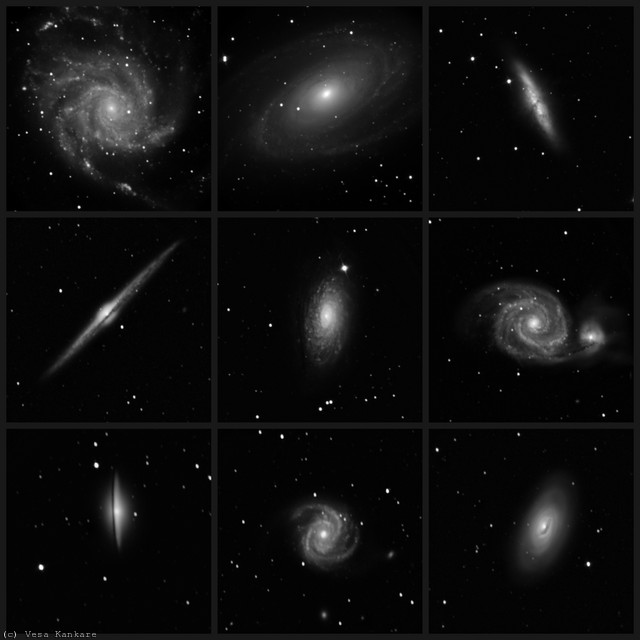
Camera: Atik Instruments 4000LE | Telescope: Ursa Artjärvi Observatory 91cm f3.75 Astrofox Folded Newton | Mount: Ursa Dome 1 | Filters: Baader IR/UV block | Guiding: - | Exposure: L 9 to 21x20s per image binned 3x3 CCD @ -20° f3.75 | Software: CCDWare CCDStack, Adobe Photoshop CS4, GradientXTerminator Plugin, Artemis Capture | Location: 60°44'00"N 26°12'46"E (Tähtikallio Observatory/Artjärvi, FI) | Background sky brightness (SQM): 20.99 mag/arcsec² | Target altitude in the beginning of the exposure 61°
NGC4565 - The Needle Galaxy
18:55 27/3/2009 UTC
The Needle, which is also known as The Flying Saucer Galaxy, is a very attractive spiral galaxy seen edge on from Earth. It is located in Coma Berenices. The equatorial dust lane is clearly visible crossing the central bulge. This fine spring sky object resembles our Milky Way. It spans about 100 000 light years across and it is close to us - in cosmic scale. Distance is 30-50 million light years depending on the source. Few tens of million light years here or there, nice object anyway. Must be a nice view visually also in a dark observing location.
NGC/IC Object List:
NGC4565 galaxy RA:12h36m20.5 Dec:+25°59m'16" BMag:10.3, UGC 7772
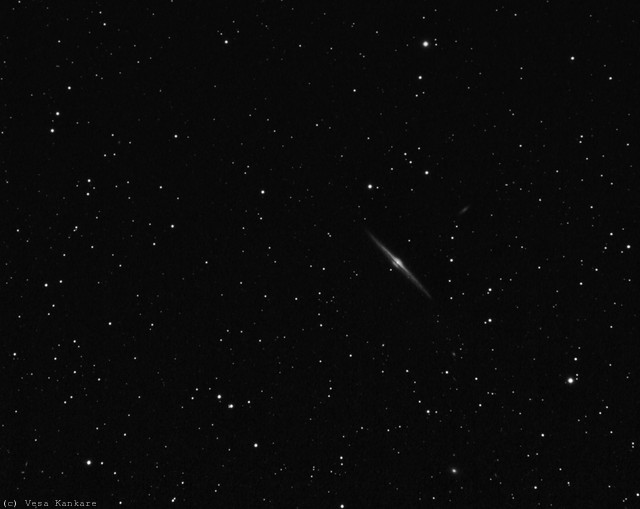
Camera: Atik Instruments 4000LE | Telescope: Skywatcher ED80 Pro 80mm f7.5 refractor, William Optics 0.8x focal reducer | Mount: Vixen GP-D2, Boxdoerfer PowerFlex MTS-3SLP drive controller | Filters: Baader IR/UV block | Guiding: The Imaging Source DMK 21AU04.AS CCD camera, Orion ShortTube 80mm f5 refractor, Stark-Labs PHD Guiding | Exposure: L: 43x180s(2h9m) CCD @ -20°C f6 | Software: CCDWare CCDStack, Adobe Photoshop CS4, Artemis Capture, GradientXTerminator Plugin | Location: 60°31'N 26°52'E (Koivula/Kotka,FI) | Image Field: 1.645 x 1.309 degrees | Image Center: Ra 12h37m14s Dec +25°57'58" | Target altitude in the beginning of the exposure 40°